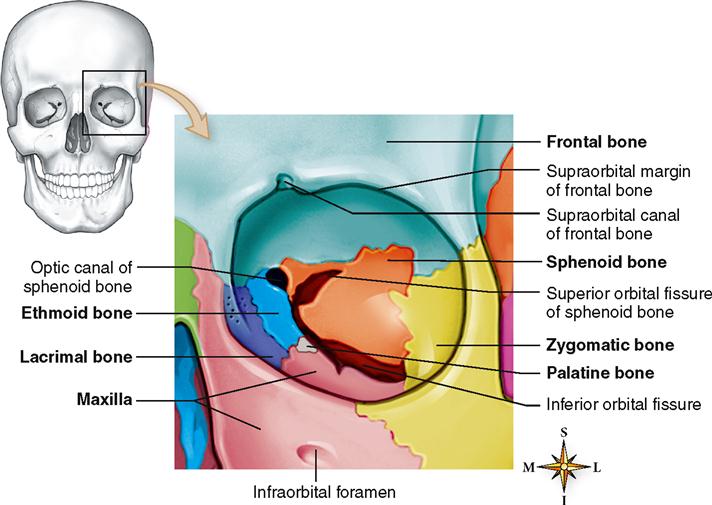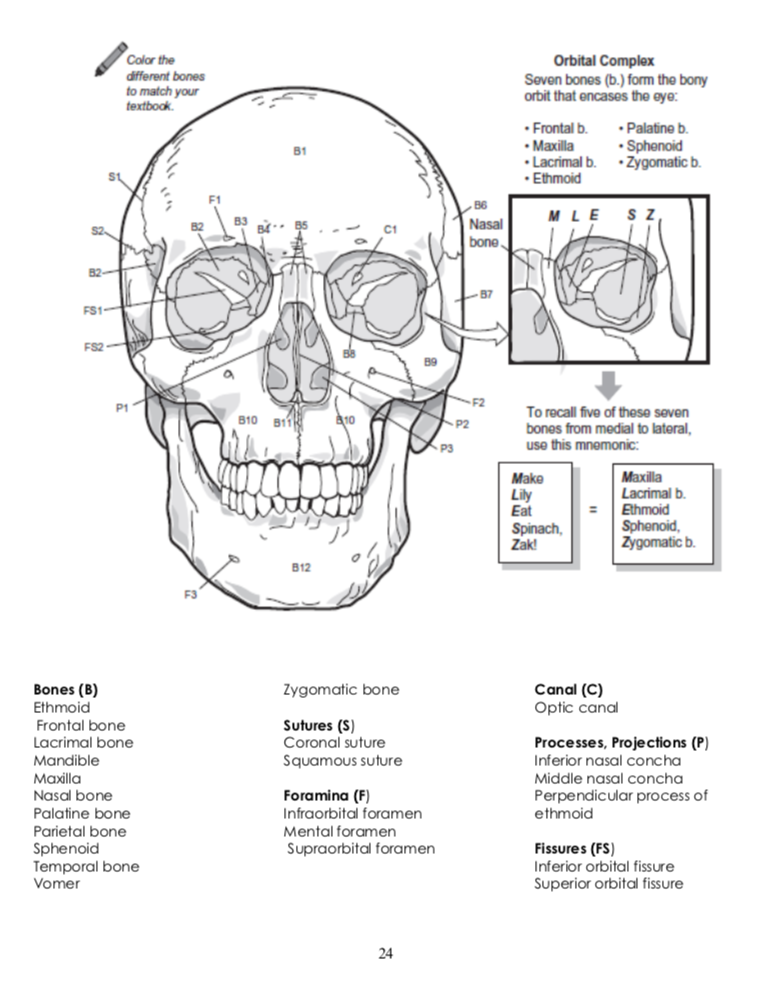What Bones Form The Orbit
What Bones Form The Orbit - The orbital roof is formed by the lesser wing of the sphenoid bone and the frontal bone. The orbit is comprised of seven distinct cranial bones. The frontal, sphenoid, zygomatic, ethmoid, lacrimal, palatine and maxilla bones. Web the boundaries of the orbit are formed by seven bones. Frontal, ethmoid, palatine, lacrimal, maxilla, zygomatic, and sphenoid. Palatine, zygomatic, lacrimal, and maxilla. There are seven orbital bones that make up this structure: The orbital roof is formed by the lesser wing of the sphenoid bone and the frontal bone. Optic foramen orbital margin (rim): Although simple, this fact constitutes the basis of the human stereoscopic vision and.
This pyramid, however, is not straight, but displays a laterally tilted axis (black outline in (c) and (d)). Maxilla, frontal bone, zygomatic bone, ethmoid bone, lacrimal bone, sphenoid bone, and palatine bone. Orbital plate of the frontal bone. The orbit is a pear shape, with the optic nerve at the stem, and holds approximately 30 cc volume. Web the seven bones that form the orbit: Lesser wing of the sphenoid bone. Web key facts about bones of the orbit. Web the structure of the orbit is made up of several orbital bones that provide a strong base for the eye so that it can perform its functions properly. Ct is the modality of choice for orbital bone imaging; Pars orbitalis of the frontal bone lacrimal bone lamina papyracea of the ethmoid bone orbital process of the zygomatic bone orbital surface of the maxillary bone orbital process of the palatine bone greater and lesser wings and body of the sphenoid bone
The sphenoid and ethmoid bones form mostly via endochondral ossification while the frontal bone is formed by intramembranous ossification. The entrance to the globe anteriorly is approximately 35 mm high and 45 mm wide. Frontal, sphenoid, maxillary, zygomatic, palatine, ethmoid, and lacrimal. Frontal, ethmoid, palatine, lacrimal, maxilla, zygomatic, and sphenoid. Web seven bones form each orbit: Web the seven bones that form the orbit: The orbit is a pear shape, with the optic nerve at the stem, and holds approximately 30 cc volume. Yellow = frontal bone green = lacrimal bone brown = ethmoid bone blue = zygomatic bone purple = maxillary bone aqua = palatine bone red = sphenoid bone teal = nasal bone (illustrated but not part of the orbit) Web the bones of the orbit develop via both endochondral and intramembranous ossification. Each of these plays a role in keeping the eyeball protected.
Bones of orbit lateral wall Human anatomy and physiology, Human
The orbit is comprised of seven distinct cranial bones. Bones, muscles, arteries, veins and nerves this is an anatomy video tutorial covering the. Ct is the modality of choice for orbital bone imaging; The lateral wall comprises the greater wing of the sphenoid bone and zygomatic bone. The sphenoid and ethmoid bones form mostly via endochondral ossification while the frontal.
Skeletal System Basicmedical Key
The sphenoid and ethmoid bones form mostly via endochondral ossification while the frontal bone is formed by intramembranous ossification. Bones, muscles, arteries, veins and nerves this is an anatomy video tutorial covering the. The entrance to the globe anteriorly is approximately 35 mm high and 45 mm wide. Optic foramen orbital margin (rim): Zygomatic process of the maxilla and the.
The Bony Orbit Borders Contents Fractures TeachMeAnatomy
Zygomatic process of the maxilla and the zygomatic bone zygomatic process of the. Yellow = frontal bone green = lacrimal bone brown = ethmoid bone blue = zygomatic bone purple = maxillary bone aqua = palatine bone red = sphenoid bone teal = nasal bone (illustrated but not part of the orbit) Web names of the bones of the orbit.
Anatomy bones, Orbit anatomy, Anatomy
However, mri can be a valuable adjunct in certain osseous pathologies especially in determining bone marrow involvement. Web the structure of the orbit is made up of several orbital bones that provide a strong base for the eye so that it can perform its functions properly. The sphenoid and ethmoid bones form mostly via endochondral ossification while the frontal bone.
20 best Ophtho images on Pinterest Anatomy, Anatomy reference and
Ct is the modality of choice for orbital bone imaging; Web right anterior view of the bony orbit. Formed by the lesser wing of the sphenoid and the frontal bone. Lesser wing of the sphenoid bone. The orbit is comprised of seven distinct cranial bones.
Orbital Bone Anatomy Human Anatomy Diagram Medical anatomy, Human
The depth from orbital rim to the orbital apex measures 40 to 45 mm in adults. Portions of six bones form its pyramidal walls: It is our job as ophthalmologists to be able to readily identify these bones and know pretty much every bump, notch, hole, and contour of these bones and what structures pass through, travel along, and attach.
bones that form the orbit Diagram Quizlet
Web let's look at how these seven orbital bones join to form different parts of the eye socket (orbit): Web bones of the orbit and some of the major landmarks. Palatine, zygomatic, lacrimal, and maxilla. The orbital roof is formed by the lesser wing of the sphenoid bone and the frontal bone. Formed by the greater wing of the sphenoid.
Bones of the orbit Human anatomy and physiology, Anatomy, Orbit anatomy
Web anatomy of the orbit the skull is composed of two segments, the cranium and the face. Formed by the lesser wing of the sphenoid and the frontal bone. Web the bony orbit and ocular adnexa provide globe protection, allowing normal function and vision. Web the boundaries of the orbit are formed by seven bones. Web the bones of the.
Bones That Form The Orbit / Orbital Bones Ophthalmology Review
The frontal, sphenoid, zygomatic, ethmoid, lacrimal, palatine and maxilla bones. Frontal, sphenoid, maxillary, zygomatic, palatine, ethmoid, and lacrimal. The lateral wall comprises the greater wing of the sphenoid bone and zygomatic bone. Zygomatic process of the maxilla and the zygomatic bone zygomatic process of the. Maxilla, frontal bone, zygomatic bone, ethmoid bone, lacrimal bone, sphenoid bone, and palatine bone.
Solved Color the different bones to match your Orbital
Lesser wing of the sphenoid bone. Yellow = frontal bone green = lacrimal bone brown = ethmoid bone blue = zygomatic bone purple = maxillary bone aqua = palatine bone red = sphenoid bone teal = nasal bone (illustrated but not part of the orbit) The entrance to the globe anteriorly is approximately 35 mm high and 45 mm wide..
Web Seven Bones Form Each Orbit:
Web let's look at how these seven orbital bones join to form different parts of the eye socket (orbit): The sphenoid and ethmoid bones form mostly via endochondral ossification while the frontal bone is formed by intramembranous ossification. Although simple, this fact constitutes the basis of the human stereoscopic vision and. The lateral wall comprises the greater wing of the sphenoid bone and zygomatic bone.
Web The Bony Orbit And Ocular Adnexa Provide Globe Protection, Allowing Normal Function And Vision.
The orbit is a pear shape, with the optic nerve at the stem, and holds approximately 30 cc volume. Formed by the lesser wing of the sphenoid and the frontal bone. Frontal, ethmoid, palatine, lacrimal, maxilla, zygomatic, and sphenoid. Portions of six bones form its pyramidal walls:
Web The Following Seven Bones Form The Orbit:
Seven bones conjoin to form the. It is our job as ophthalmologists to be able to readily identify these bones and know pretty much every bump, notch, hole, and contour of these bones and what structures pass through, travel along, and attach to these bones. The entrance to the globe anteriorly is approximately 35 mm high and 45 mm wide. Web key facts about bones of the orbit.
The Orbital Roof Is Formed By The Lesser Wing Of The Sphenoid Bone And The Frontal Bone.
Web the seven bones that form the orbit: Frontal, sphenoid, maxillary, zygomatic, palatine, ethmoid, and lacrimal. Formed by the greater wing of the sphenoid bone and the zygomatic bone. The cranium is the major portion and it consists of three unpaired bones, the sphenoid, occipital, and ethmoid bones, and three paired bones, the frontal, parietal, and temporal bones.








